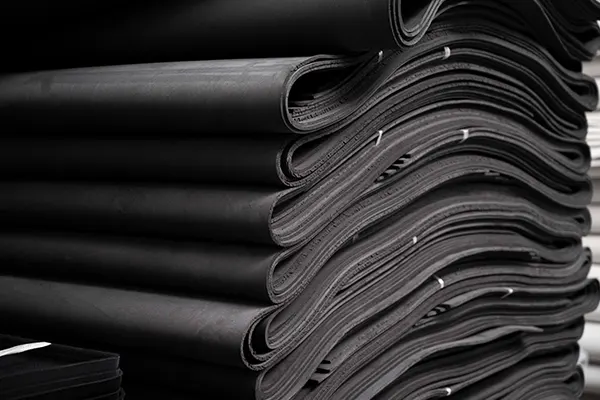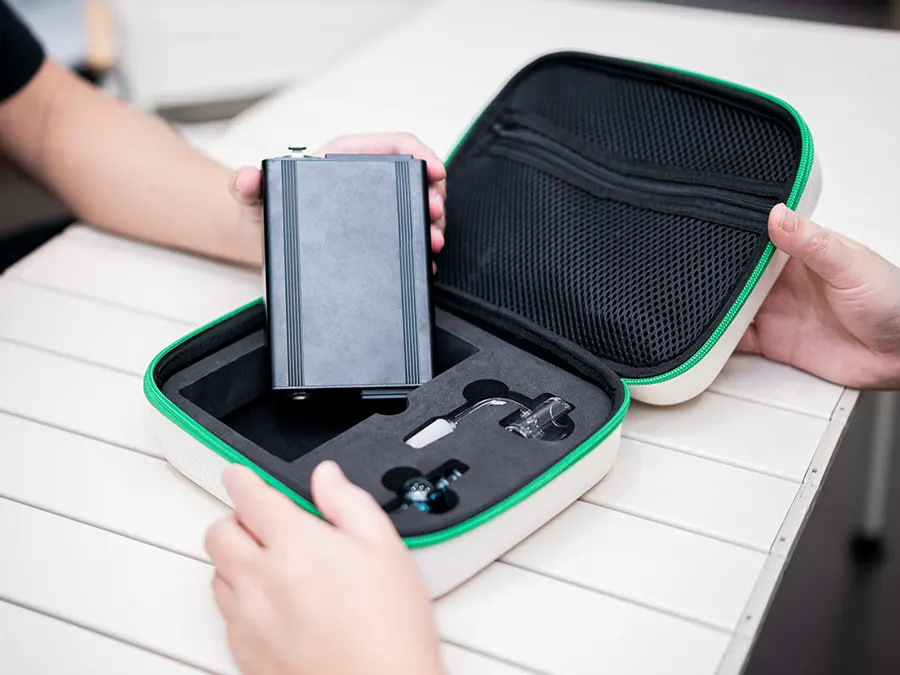Выбор правильного материала для вашего проекта или продукта имеет важное значение для достижения оптимальных результатов.. EVA и PVC являются двумя часто используемыми материалами в различных отраслях из -за их уникальных свойств и универсальности. В этом комплексном руководстве, Мы углубимся в характеристики как EVA, так и PVC, чтобы помочь вам принять обоснованное решение, которое лучше подходит для ваших конкретных потребностей. Давайте внимательно рассмотрим, что отличает эти материалы.
Что такое материал ЭВА?

Этилен-винил ацетат (Ева) это сополимер, который известен своим легким и гибким характером. Обычно используется в производстве пенопластовых продуктов, такие как подошва обуви, спортивное оборудование, и упаковочные материалы для производства корпуса EVA. EVA также ценится за его поглощение шока, Сделать его идеальным выбором для защитного снаряжения и амортизационных применений.
Что такое материал ПВХ?

Поливинилхлорид (ПВХ) является синтетическим пластиковым полимером, который известен своей долговечностью и долговечностью. ПВХ очень универсален и может быть найден в широком ассортименте продуктов, в том числе трубы, оконные рамы, полы, и вывески. Его водонепроницаемые и пламени-ретаративные свойства делают его популярным выбором для наружного и строительного применения.
Свойства материала ЭВА

Легкий и гибкий
Одной из выдающихся особенностей EVA является ее легкая и гибкая природа, Что облегчает работу и удобно носить. Это качество особенно полезно в отраслях, которые требуют, чтобы продукты были легкими, но долговечными, такие как обувь и материалы для прокладки.
Шоковые возможности
EVA ценится за его исключительные возможности поглощения шока, Сделать его идеальным материалом для устойчивых к воздействию продуктов, таких как лайнеры шлема и защитная прокладка. Его способность смягчить и поглощать силы воздействия помогает снизить риск травм в ситуациях с высоким воздействием..
Погода
Еще одним преимуществом EVA является его устойчивая к погоде свойства, что позволяет ему противостоять воздействию элементов без ухудшения. Это делает EVA надежным выбором для наружных применений, где долговечность и долговечность необходимы.
Без запаха и нетоксично
Ева известна тем, что является без запаха и нетоксична, Сделать его безопасным выбором для продуктов, которые вступают в контакт с кожей или едой. Его нетоксичная природа также делает его экологически чистым, поскольку он не выпускает вредные химические вещества в окружающую среду.
Свойства материала из ПВХ
Долговечный и долговечный
ПВХ известен своей долговечностью и долговечной производительностью, Сделать его популярным выбором для продуктов, которые требуют высокого уровня силы и устойчивости. Его способность противостоять износу со временем делает его экономически эффективным вариантом для долгосрочного использования.
Водостойкий
Одним из ключевых преимуществ ПВХ являются его водонестойкие свойства, что делает его очень подходящим для применений, где воздействие влаги вызывает беспокойство. ПВХ не поглощает воду, Сделать его идеальным выбором для наружной и морской среды.
Пламя-возобновляющий
ПВХ по своей сути пламен, это означает, что он обладает высокой сопротивлением зажиганию и не распространяет пламя легко. Это делает ПВХ предпочтительным материалом для применений, где пожарная безопасность является приоритетом, такие как строительство здания и электрическая проводка.
Универсальный в приложениях
ПВХ очень универсален и может быть адаптирован для использования в широком спектре приложений, От трубопроводов и оконных рам до медицинских устройств и вывесок. Его универсальность и настраиваемые свойства делают его материалом для различных отраслей промышленности.
Ева против. ПВХ, Что лучше?
При сравнении EVA и PVC, В игру вступают несколько ключевых факторов:
Вес и гибкость
Ева легче и более гибкая, чем ПВХ, сделать его предпочтительным выбором для приложений, которые требуют более мягкого прикосновения и большего комфорта.
ПВХ, с другой стороны, более крепкий и менее гибкий, сделать его лучше подходящим для жестких структур.
Долговечность и долговечность
ПВХ известен своей долговечностью и долгосрочной производительностью, Сделать его надежным выбором для продуктов, которые должны выдерживать сильное использование и резкие условия.
Ева, Хотя это не так долговечно, как ПВХ, предлагает отличные амортизаторы и амортизационные свойства.
Сопротивление к погодным элементам
Ева устойчива к погоде и может противостоять воздействию элементов без ухудшения, сделать его подходящим для открытых применений.
ПВХ также устойчив к погоде и может сопротивляться влажности и колебаниям температуры, Сделать его надежным выбором для использования на открытом воздухе.
Тепло и устойчивость
ПВХ обладает более высокой толерантностью к тепло и холодным температурам по сравнению с EVA, сделать его подходящим для применений, которые требуют термической стабильности.
Ева может смягчить или затвердевать при экстремальных температурах, который может повлиять на его производительность в определенных средах.
Сравнение затрат
С точки зрения стоимости, EVA, как правило, более доступна, чем ПВХ из -за более низких производственных затрат. Однако, Продолжительность и долговечность ПВХ могут компенсировать первоначальные инвестиции, сделать его экономически эффективным выбором в долгосрочной перспективе для определенных приложений.
Приложения в отрасли
И EVA, и PVC находят широкий спектр приложений в различных отраслях промышленности:
Приложения EVA
- Обувь: EVA-популярный материал для изготовления подошвы и стельки для обуви из-за его легких и амортизирующих свойств.
- Спортивное оборудование: EVA используется в производстве спортивной прокладки, шлемы, коврики, и схватки для спортивного оборудования.
- Защитное снаряжение: Превосходное шоковое поглощение EVA делает его идеальным материалом для создания защитного снаряжения, такого как шлемные вкладыши и прокладки для спортивного и защитного оборудования.
- Упаковочные материалы: EVA также используется при производстве упаковочных материалов, включая EVA Hard Shell Case для электроники, инструменты, и деликатные предметы.
Приложения из ПВХ
- Трубопровод: Трубы из ПВХ широко используются в сантехнике, ирригация, и дренажные системы для их долговечности, коррозионная стойкость, и простота установки.
- Оконные рамы: ПВХ является распространенным материалом для производства оконных рам и профилей из -за его сопротивления погоде, низкие требования к техническому обслуживанию, и энергоэффективность.
- Полы: ПВХ Пол, в том числе виниловая плитка и виниловая доля пола, популярен за долговечность, водонепроницаемость, и широкий ассортимент дизайнов.
- Электрическая изоляция: ПВХ используется в электрических приложениях для кабельной изоляции, проводка, и электрический трубопровод из-за его пламени и изоляционных свойств.
- Вывески: ПВХ листы и доски обычно используются для вывесок в помещении и на открытом воздухе из -за их долговечности, Погодная сопротивление, и простота настройки.
Ева против. ПВХ, Что выбрать?
При выборе между EVA и PVC для вашего проекта или продукта, Рассмотрим следующие факторы:
- Если вы определяете приоритеты в легком весе и гибкости, Ева может быть лучшим выбором.
- Для применений, которые требуют долговечности и долговечности, ПВХ может быть более подходящим.
- Погодная сопротивление, теплоемкость, и соображения стоимости также должны направлять ваше решение.
Заключение
В заключение, И EVA, и PVC предлагают уникальные свойства и преимущества, которые делают их ценными материалами в различных отраслях промышленности. Понимание ключевых различий между EVA и PVC, такие как вес, гибкость, долговечность, Погодная сопротивление, и стоимость, поможет вам принять обоснованное решение, в котором материал лучше подходит для ваших конкретных потребностей. Выбираете ли вы EVA или PVC, Оба материала обеспечивают универсальность, производительность, и надежность для широкого спектра приложений.
















